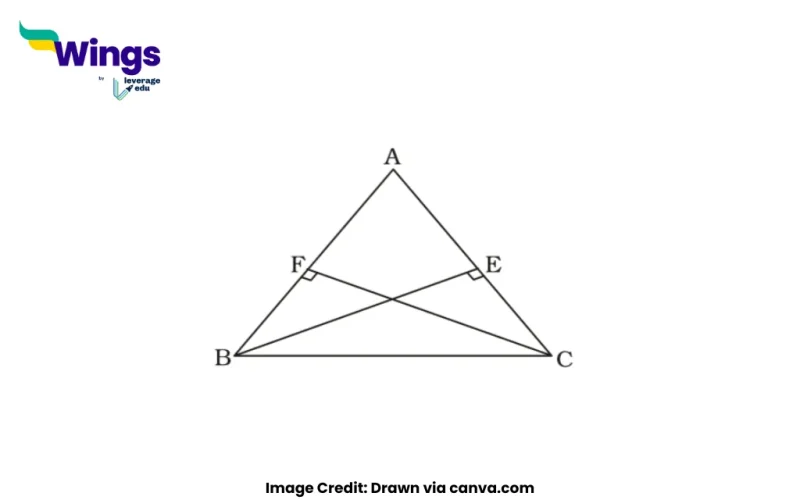If two altitudes of a triangle are equal in length, then the triangle is an isosceles triangle. This can be proved using fundamental geometric principles and properties of altitudes.
Understanding Altitudes in a Triangle
An altitude of a triangle is a perpendicular segment drawn from a vertex to the opposite side (or its extension). Every triangle has three altitudes, which may or may not be of equal length depending on the triangle’s type.
Properties of Altitudes:
- Each altitude is perpendicular to the corresponding base.
- The intersection of all three altitudes is called the orthocenter of the triangle.
- In an isosceles triangle, at least two altitudes are equal.
Given Condition: Two Altitudes Are Equal
Let us consider a triangle ABC, where two of its altitudes are equal in length. Our goal is to prove that this condition implies the triangle is isosceles.
Step-by-Step Proof:
- Construct Altitudes:
- Let AD and BE be the two equal altitudes in triangle ABC.
- AD is drawn from A to BC, and BE is drawn from B to AC, both perpendicular to their respective bases.
- Triangle Properties:
- Since AD = BE, the two right-angled triangles ABD and ABE are formed.
- Both triangles share the common angle ∠ADB=∠AEB=90∘\angle ADB = \angle AEB = 90^\circ.
- Applying Right-Triangle Congruence (RHS Rule):
- In right-angled triangles ABD and ABE:
- AD = BE (Given condition)
- ∠ADB=∠AEB=90∘\angle ADB = \angle AEB = 90^\circ (Right angles)
- AB = AB (Common hypotenuse)
- By the RHS Congruence Theorem, triangle ABD \cong triangle ABE.
- In right-angled triangles ABD and ABE:
- Consequence of Congruence:
- Since the corresponding sides of congruent triangles are equal, we get: BD = EC.
- This implies that triangle ABC is symmetric about the perpendicular bisector.
- Conclusion:
- Since two sides of triangle ABC are equal (AB = AC), it follows that ABC is an isosceles triangle.
Summary of Proof in a Table
Here is a table to understand the properties
| Step | Explanation |
| 1. Construct Altitudes | Two equal altitudes, AD and BE, are drawn in triangle ABC. |
| 2. Identify Right Angles | ∠ADB=∠AEB=90∘\angle ADB = \angle AEB = 90^\circ. |
| 3. Apply RHS Congruence | Right triangles ABD and ABE are congruent. |
| 4. Use Congruence Properties | Corresponding sides are equal: BD = EC. |
| 5. Conclusion | Triangle ABC is isosceles with AB = AC. |
Practical Implications of the Result
Understanding this property helps in:
- Triangle classification: If two altitudes are equal, we can immediately identify the triangle as isosceles.
- Problem-solving: This theorem is useful in geometric proofs and constructions.
- Real-life applications: Architectural designs and engineering structures use symmetrical properties of isosceles triangles for stability.
Thus, we have rigorously proved that if two altitudes of a triangle are equal, then the triangle must be isosceles. This proof strengthens our understanding of geometric properties and congruence theorems, making it a valuable concept in mathematics.
Common Doubts
 60,000+ students trusted us with their dreams. Take the first step today!
60,000+ students trusted us with their dreams. Take the first step today!


 One app for all your study abroad needs
One app for all your study abroad needs










